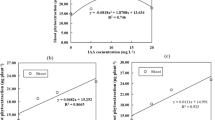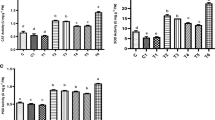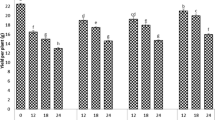Abstract
A microcosm experiment with artificially contaminated soils was conducted in a greenhouse to evaluate the effect of gibberellic acid 3 (GA3) on phytoremediation efficiency of Solanum nigrum L. The GA3 was applied at three different concentrations (10, 100, 1000 mg L−1) to S. nigrum. Results indicated that GA3 can significantly (p < 0.05) increase the biomass of S. nigrum by 56 % at 1000 mg L−1. Concurrently, GA3 application increased Cd concentrations in the shoot of S. nigrum by 16 %. The combined effects resulted in an increase in the amount of Cd extracted by a single plant by up to 124 %. Therefore, it is possible to use GA3 to promote the Cd phytoremediation efficiency of S. nigrum.
Similar content being viewed by others
Explore related subjects
Discover the latest articles, news and stories from top researchers in related subjects.Avoid common mistakes on your manuscript.
In recent decades, human activities such as intensive industrialization and urbanization, agricultural activities and inadequate waste disposal have resulted in significant soil contamination by heavy metals (Sun et al. 2009). In China, soil heavy metal pollution has become a serious problem which may block the process of building the harmonious society desired by the Chinese government in recent years. According to China’s National Soil Pollution Survey Bulletin (NSBSP) issued jointly by the Ministry of Environmental Protection and the Ministry of Land, the national total percentages of soil heavy metal pollution exceeded 16.1 %, in which slight, mild, moderate, and severe contamination of soils was, respectively, 11.2 %, 2.3 %, 1.5 %, and 1.1 %. Soil Cd and Pb pollution were ranked at the 1st and 5th worst, with pollution percentages being 7.0 % and 1.5 %, respectively (Sun et al. 2015). In addition, China’s Ministry of Agriculture in 2002 showed that of the heavy metals examined in brown rice, Pb had the highest percentage (28.4 %) exceeding the recommended safe level, followed by Cd (10.3 %) (Li et al. 2003). Therefore, with the continuing need to sustain and even increase agricultural output it will be imperative to clean up the heavy metals in contaminated soils to prevent compromised agriculture production from entering the human food supply.
According to the published literature, there are a number of conventional methods that are being used to remove heavy metals from the soils, including soil incineration, in situ vitrification, soil washing, excavation and landfill, soil flushing, solidification, and stabilization of electro-kinetic systems have been employed for such remediation purposes (Sheoran et al. 2010; Shi et al. 2009; Zhang et al. 2015). However, physical and chemical remediation methods tend to damage the soil environment and are always high cost, and involve intensive labor and cause irreversible changes in soil properties. Compared to physical and chemical methods, phytoremediation that uses plants to remove or degrade contaminants from the soil, is reported to be a cost-effective, efficient and environment-friendly remediation method (Singh and Prasad 2011; Vithanage et al. 2012). However, hyper-accumulating plants, as the core of phytoremediation, often grow slowly and have low biomass, resulting in a low phytoremediation efficiency. Therefore, many methods, including agricultural strategies and chemical agents have been examined for enhancing the phytoremediation efficiency (Brown et al. 1995; Hammer and Keller 2003; Koopmans et al. 2008; Luo et al. 2006), through increasing the biomass by agricultural management or stimulating accumulation by use of chemical agents (e.g. EDTA).
Plant growth regulators, such as indole-3-acetic acid (IAA) and gibberellins (GAs), are widely used in agriculture research (Tassi et al. 2008). Gibberellins (GAs) are a type of diterpenoid compound and act as a vegetable hormone that activates cell division as well as cell enlargement processes (Mahouachi et al. 2009). GAs are involved in every aspect of plant growth and development, but their most observable effect is the enhancement of stem growth, since GAs can overcome apical dominance (Nishijima et al. 1994).
Among the heavy metals, Cd contamination is of particular concern in some parts of China. Pan and his coworkers have found that about 10.0 % of all rice grown and sold in China failed to meet the government standards for Cd (Gu and Zhou 2002). Therefore, considerable research effort has been expended on remediation studies for Cd. Solanum nigrum L. has been found to be an effective hyper-accumulator for use in Cd phytoremediation (Wei et al. 2005), and the phytoremediation efficiency of S. nigrum can be enhanced significantly with different agricultural management strategies (Ji et al. 2011). In this study, we examine the use of gibberellic acid 3 (GA3) on S. nigrum to determine plant growth, its effect on Cd uptake, the overall impact of its use in phytoremediation of Cd-contaminated soils.
Materials and Methods
This study is based on the same methods as published by Ji et al. (2015). The original experimental soil was collected from Shaanxi Province (Table 1). To conduct the experiment, the Cd concentration of the original soil was adjusted to 1.0 mg kg−1 with Cd(NO3)2 6 months before use. Locally obtained seeds of S. nigrum were sown uniformly in a seedling culture plate and propagated in a greenhouse maintained at 40 %–60 % relative humidity, in natural sunlight and a temperature regime of 21/15°C (day/night), 1 month before the experiment was launched. The soil water holding capacity (WHC) was kept at 80 %. Twenty experimental pots with a diameter of 30 cm and a depth of 20 cm were filled with 5 kg prepared soil. Three seedlings with four to six mature leaves were transplanted into each pot before being placed in a greenhouse covered by a shading net. The greenhouse was protected from rain, and the moisture of experimental soils was kept at 60 % of the WHC.
Seven days after transplanting, GA3 treatment commenced. Five pots were used for a control (CK), and five were used for each treatment as replicates of three GA3 solution application concentrations (10, 100 and 1000 mg L−1). Twenty milliliters of aqueous solution of the different concentrations of GA3 were applied to the corresponding experimental microcosms; the solutions were sprayed to the surface of leaves using a hand-operated sprayer. Solutions were applied every 7 days (a total of five times) during the experiment. After 45 days, plants were harvested and prepared for analyses.
Upon harvesting, bulk soil was carefully washed with deionized water to make sure the integrity of root system, then physiological parameters of the plants were measured. Areas of mid-height leaves were measured by a leaf area meter (LI-COR Company Portable leaf area meter LI-3000C, Beijing Ecotek Technology Co., Ltd, Beijing, China). Tap-root length and plant height were measured using a flexible tape. Harvested plants were separated into roots, stems and leaves. Each part was rinsed with tap water to clean soil surface before carefully washed with deionized water. Fresh samples were oven-dried at 105°C for 30 min, then at 70°C until constant weight was obtained.
Cd analysis was carried out in accordance with Ji et al. (2011) using a Perkin Elmer model AA-400 spectrophotometer (Perkin Elmer Corporation, USA). The detection limit for Cd was 0.020 mg kg−1. For quality control, standard materials (GBW-08505) were purchased from the China Standard Materials Research Center, Beijing, PR China. Recovery rates of 95 % ± 5 % were obtained using standard methods described above.
Results were expressed as mean ± SD, and statistical significance of differences between groups was evaluated by analysis of variance (ANOVA) and compared using least significant difference (LSD) at p < 0.05. Pearson correlation coefficients with 95 % confidence intervals were calculated to examine relationships.
Results and Discussion
Phytoremediation efficiency is mainly dependent on the harvestable biomass and the metal concentrations in the aerial plant parts. In this study, effects of GA3 on phytoremediation efficiency of S. nigrum were determined by measuring plant growth parameters and Cd uptake ability. According to Fig. 1, different application rates of GA3 had no significant effect on the plant root length or height. This is in contrast to a study by Vengadesan et al. (2002) who reported that 60 mg L−1 GA3 applied to Acacia sinuata multiplied shoot elongation.
The GA3-1000 and GA3-100 treatments caused enlargement of the leaf size by 56 % and 20 %, respectively, compared to the CK. A significantly positive co-relationship existed between GA3 application concentrations and leaf size (r2 = 0.768, p < 0.01). This suggests GA3 can improve leaf growth of S. nigrum. The GA3-1000, GA3-100 and GA3-10 treatments increased the single plant biomass by 56 %, 23 % and 14 %, respectively, demonstrating a significantly positive co-relationship (r2 = 0.823, p < 0.05) between biomass and GA3 application concentrations. Hadi et al. (2014) reported GA3 application to Parthenium hysterophorus significantly increased plant growth and biomass in a Cd-contaminated soil compared to control treatment. Due to the ability of GA3 to promote cell division, plant shoot height and root length were also significantly increased (p < 0.05).
Effects of GA3 on the accumulation of Cd by S. nigrum are shown in Table 2. GA3 application did not affect Cd concentrations in the plant root. For the GA3-1000, GA3-100 and GA3-10 treatments, Cd concentrations in the stem increased by 9 %, 17 % and 14 %, respectively, while Cd concentrations in the leaf decreased by 61 %, 77 % and 81 %, respectively. There was a significant negative co-relationship (r2 = 0.796, p < 0.05) between Cd concentrations in the leaf and the GA3 application concentrations. This is similar to the study of Sun et al. (2013), in which GA3 was applied to Tagetes patula for remediation of Cd, where results indicated GA3 application decreased leaf Cd concentrations by 16 %–40 %. Cd concentrations in the overall shoot of S. nigrum were also dependent on different GA3 application concentrations. GA3-10 and GA3-100 treatments significantly enhanced Cd concentrations in the plant (p < 0.05), but the GA3-1000 treatment had no measurable effect.
Compared to CK, Cd concentrations of shoots treated by GA3-10 and GA3-100 increased by 12 % and 10 %, respectively. These results were similar to those of Hadi et al. (2010) who found when GA3 was applied to maize for enhancing Pb accumulation, GA3 significantly increased Pb uptake in roots and its translocation into stem and leaves. In a more recent study by Sun et al. (2013), GA3 was applied to T. patula for remediation of Cd, and results indicated GA3 caused a decrease of Cd concentrations in the plant tissue. Therefore, GA3 can only stimulate Cd uptake of S. nigrum on the premise of a suitable application concentration.
Table 2 shows that all three GA3 treatments can significantly enhance the Cd extraction of S. nigrum. In this study, GA3-1000, GA3-100 and GA3-10, the amount of Cd extracted by a single plant was increased by factors of 72 %, 37 % and 26 %, respectively. Hadi et al. (2010) also reported the foliar spray of GA3 on maize significantly increased the total Pb accumulation in the plant.
For phytoremediation, the bioconcentration factor (BF) and translocation factor (TF) are important measures in hyper-accumulating plants, as the removal of metals requires phytoextraction from polluted soils to the aerial parts of plants (Doty 2008). Generally, higher BF and TF values indicate a possible higher phytoremediation efficiency (McGrath and Zhao 2003). Figure 2 illustrates that BFs and TFs were all higher than 1.0, indicating S. nigrum can take up Cd and store it in aerial parts under current experimental conditions. However, GA3 application had no significant effect on the TFs and BFs of S. nigrum, so the increase in phytoremediation efficiency was derived almost entirely from the increase in biomass.
From this experimental study we have determined GA3 can be used to enhance the phytoremediation efficiency of S. nigrum. Effects observed were mainly in regard to the plant biomass, for which an increase of 56 % was observed at the highest concentration used (1000 mg L−1 GA3). There were small increases in the Cd concentration of the stem, but decreases in the Cd concentration of the leaf. Overall, the amount of Cd extracted per plant was increased by 25 % at an application rate of 10 mg L−1, 37 % at 100 mg L−1 and 72 % at 1000 mg L−1. This study provides justification for future work at a field scale in which the optimum application rate and cost-benefit ratio can be determined.
The study by Ji et al. (2015) in which the effect of IAA in the phytoremediation efficiency of S. nigrum was examined concluded that that plant hormone could increase the concentration of Cd in the aerial parts of the plant. This finding, combined with the data reported here suggests that a combination of the two plant growth regulators might be even more effective in enhancing the phytoremediation efficiency of S. nigrum. Further work would be required to verify this and determine optimum application rates.
References
Brown SL, Chaney RL, Angle JS, Baker AJ (1995) Zinc and cadmium uptake by hyperaccumulator Thlaspi caerulescens and metal tolerant Silene vulgaris grown on sludge-amended soils. Enviro Sci Technol 29:1581–1585
Doty SL (2008) Enhancing phytoremediation through the use of transgenics and endophytes. New Phytol 179:318–333
Gu J, Zhou Q (2002) Cleaning up through phytoremediation: a review of Cd contaminated soils. Ecol Sci 4:018
Hadi F, Bano A, Fuller MP (2010) The improved phytoextraction of lead (Pb) and the growth of maize (Zea mays L.): the role of plant growth regulators (GA3 and IAA) and EDTA alone and in combinations. Chemosphere 80:457–462
Hadi F, Ali N, Ahmad A (2014) Enhanced phytoremediation of cadmium-contaminated soil by Parthenium hysterophorus plant: effect of gibberellic acid (GA3) and synthetic chelator, alone and in combinations. Bioremediat J 18:46–55
Hammer D, Keller C (2003) Phytoextraction of Cd and Zn with Thlaspi caerulescens in field trials. Soil Use Manag 19:144–149
Ji P, Sun T, Song Y, Ackland ML, Liu Y (2011) Strategies for enhancing the phytoremediation of cadmium-contaminated agricultural soils by Solanum nigrum L. Environ Pollut 159:762–768
Ji P, Jiang Y, Tang X, Nguyen T, Tong Y, Gao P, Han W (2015) Enhancing of the phytoremediation efficiency using indole-3-acetic acid (IAA). Soil Sediment Contam. doi:10.1080/15320383.2015.1071777
Koopmans G, Römkens P, Fokkema M, Song J, Luo Y, Japenga J, Zhao F (2008) Feasibility of phytoextraction to remediate cadmium and zinc contaminated soils. Environ Pollut 156:905–914
Li K, Liu J, Lu X (2003) Uptake and distribution of cadmium in different rice cultivars. Agro Environ Sci 22:529–532 (in Chinese, with English abstract)
Luo C, Shen Z, Lou L, Li X (2006) EDDS and EDTA-enhanced phytoextraction of metals from artificially contaminated soil and residual effects of chelant compounds. Environ Pollut 144:862–871
Mahouachi J, Iglesias D, Agustí M, Talon M (2009) Delay of early fruitlet abscission by branch girdling in citrus coincides with previous increases in carbohydrate and gibberellin concentrations. Plant Growth Regul 58:15–23
McGrath SP, Zhao F-J (2003) Phytoextraction of metals and metalloids from contaminated soils. Curr Opin Biotechnol 14:277–282
Nishijima T, Koshioka M, Yamazaki H, Miura H, Mander L (1994) Endogenous gibberellins and bolting in cultivars of Japanese radish. Plant Growth Regul 394:199–206
Sheoran V, Sheoran A, Poonia P (2010) Role of hyperaccumulators in phytoextraction of metals from contaminated mining sites: a review. Crit Rev Environ Sci Technol 41:168–214
Shi W, Shao H, Li H, Shao M, Du S (2009) Progress in the remediation of hazardous heavy metal-polluted soils by natural zeolite. J Hazard Mater 170:1–6
Singh A, Prasad S (2011) Reduction of heavy metal load in food chain: technology assessment. Rev Environ Sci Bio-Technol 10:199–214
Sun Y, Zhou Q, An J, Liu W, Liu R (2009) Chelator-enhanced phytoextraction of heavy metals from contaminated soil irrigated by industrial wastewater with the hyperaccumulator plant (Sedum alfredii Hance). Geoderma 150:106–112
Sun Y, Xu Y, Zhou Q, Wang L, Lin D, Liang X (2013) The potential of gibberellic acid 3 (GA3) and Tween-80 induced phytoremediation of co-contamination of Cd and Benzo [a] pyrene (B [a] P) using Tagetes patula. J Environ Manag 114:202–208
Sun Y, Li Y, Xu Y, Liang X, Wang L (2015) In situ stabilization remediation of cadmium (Cd) and lead (Pb) co-contaminated paddy soil using bentonite. Appl Clay Sci 105:200–206
Tassi E, Pouget J, Petruzzelli G, Barbafieri M (2008) The effects of exogenous plant growth regulators in the phytoextraction of heavy metals. Chemosphere 71:66–73
Vengadesan G, Ganapathi A, Amutha S, Selvaraj N (2002) In vitro propagation of Acacia species—a review. Plant Sci 163:663–671
Vithanage M, Dabrowska B, Mukherjee A, Sandhi A, Bhattacharya P (2012) Arsenic uptake by plants and possible phytoremediation applications: a brief overview. Environ Chem Lett 10:217–224
Wei S, Zhou Q, Wang X, Zhang K, Guo G, Ma L (2005) A newly-discovered Cd-hyperaccumulator Solatium nigrum L. Chin Sci Bull 50:33–38
Zhang J, Zhang G, Cai D, Wu Z (2015) Immediate remediation of heavy metal (Cr(VI)) contaminated soil by high energy electron beam irradiation. J Hazard Mater 285:208–211
Acknowledgments
We acknowledge for the financial support of the Ministry of Agriculture of the People’s Republic of China (Grant No. 201203045). Thanks also to the greenhouse workers who have helped in the conducting of the work and the scientific colleagues who assisted in drafting and editing the paper.
Author information
Authors and Affiliations
Corresponding author
Rights and permissions
About this article
Cite this article
Ji, P., Tang, X., Jiang, Y. et al. Potential of Gibberellic Acid 3 (GA3) for Enhancing the Phytoremediation Efficiency of Solanum nigrum L.. Bull Environ Contam Toxicol 95, 810–814 (2015). https://doi.org/10.1007/s00128-015-1670-x
Received:
Accepted:
Published:
Issue Date:
DOI: https://doi.org/10.1007/s00128-015-1670-x






